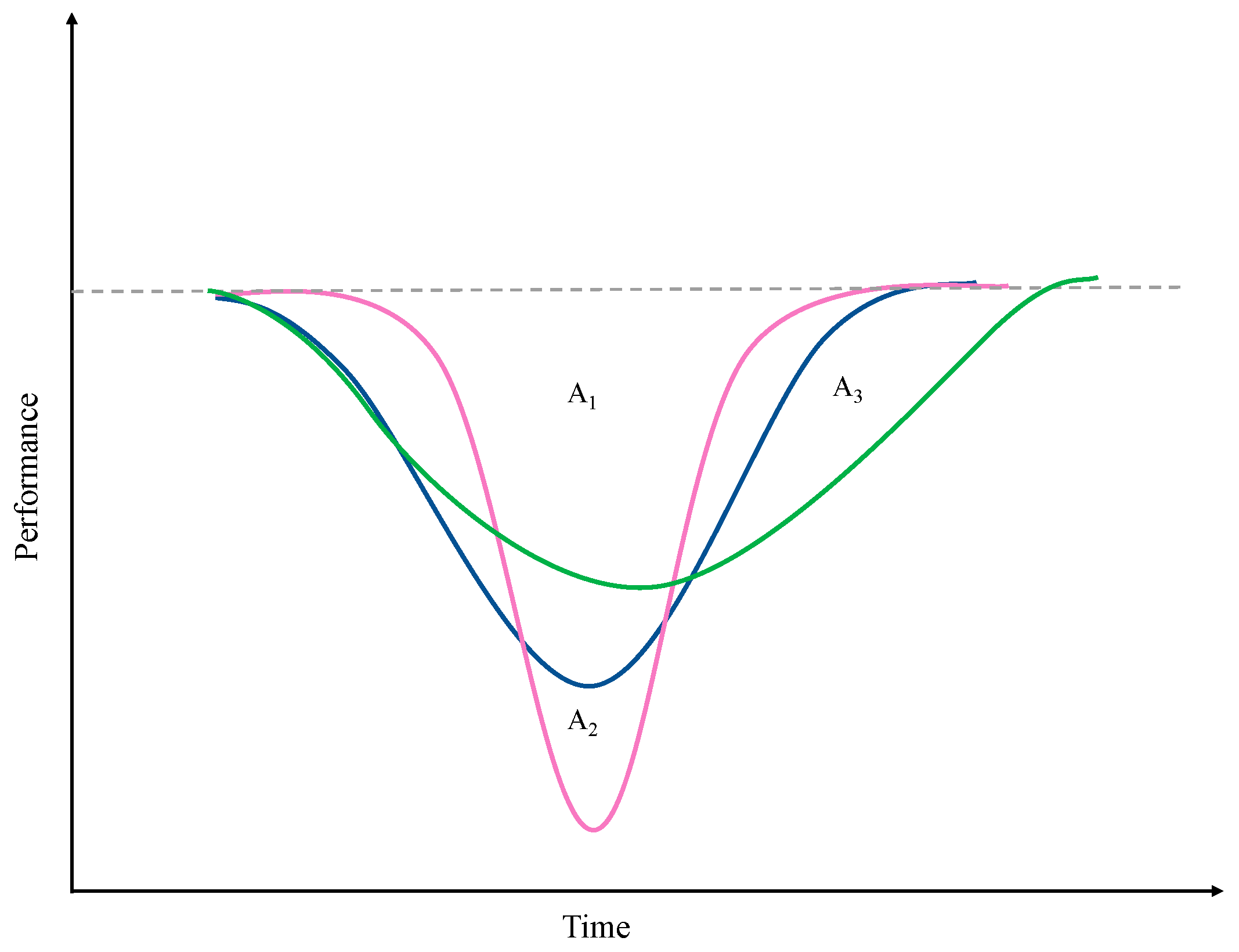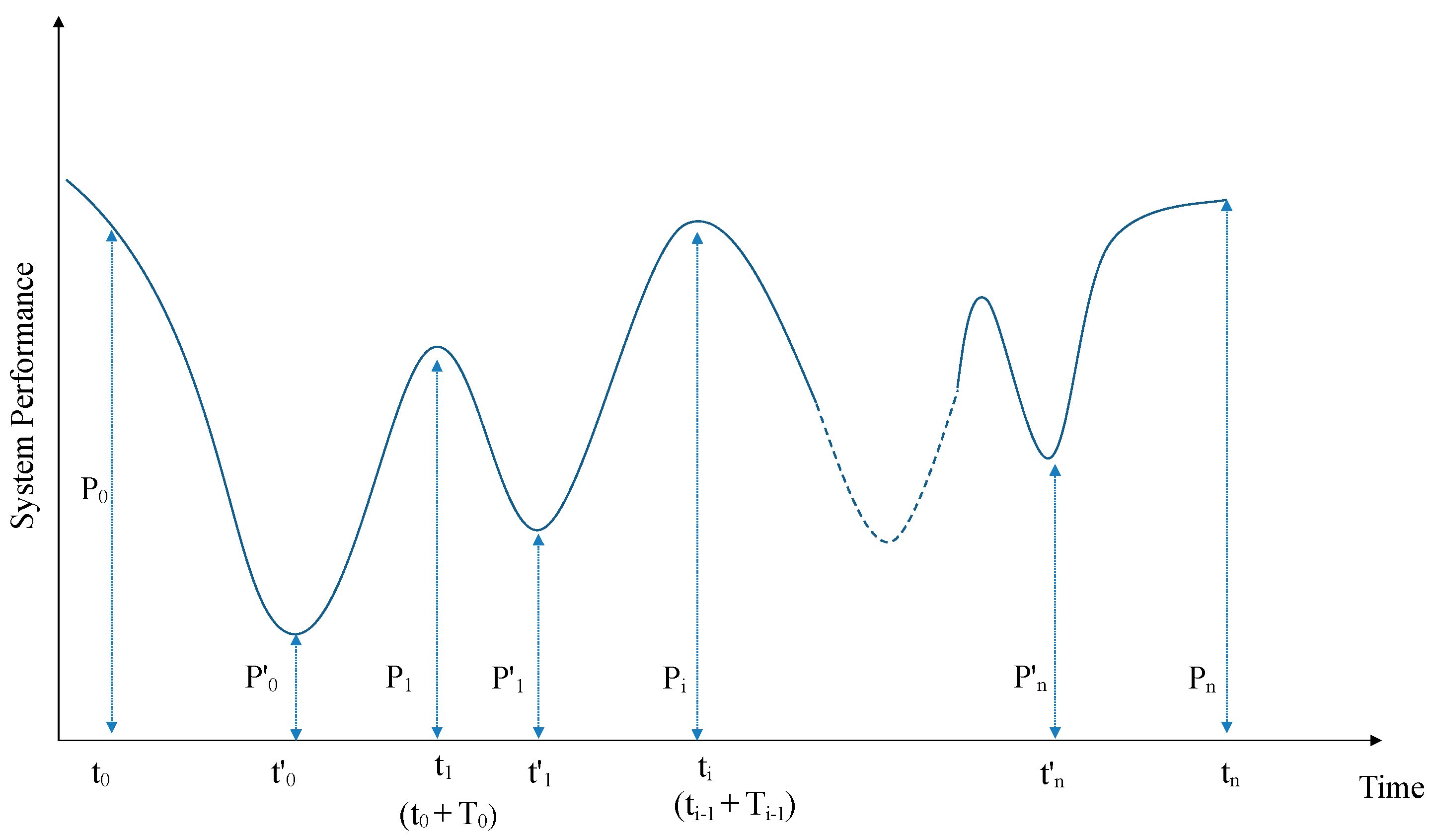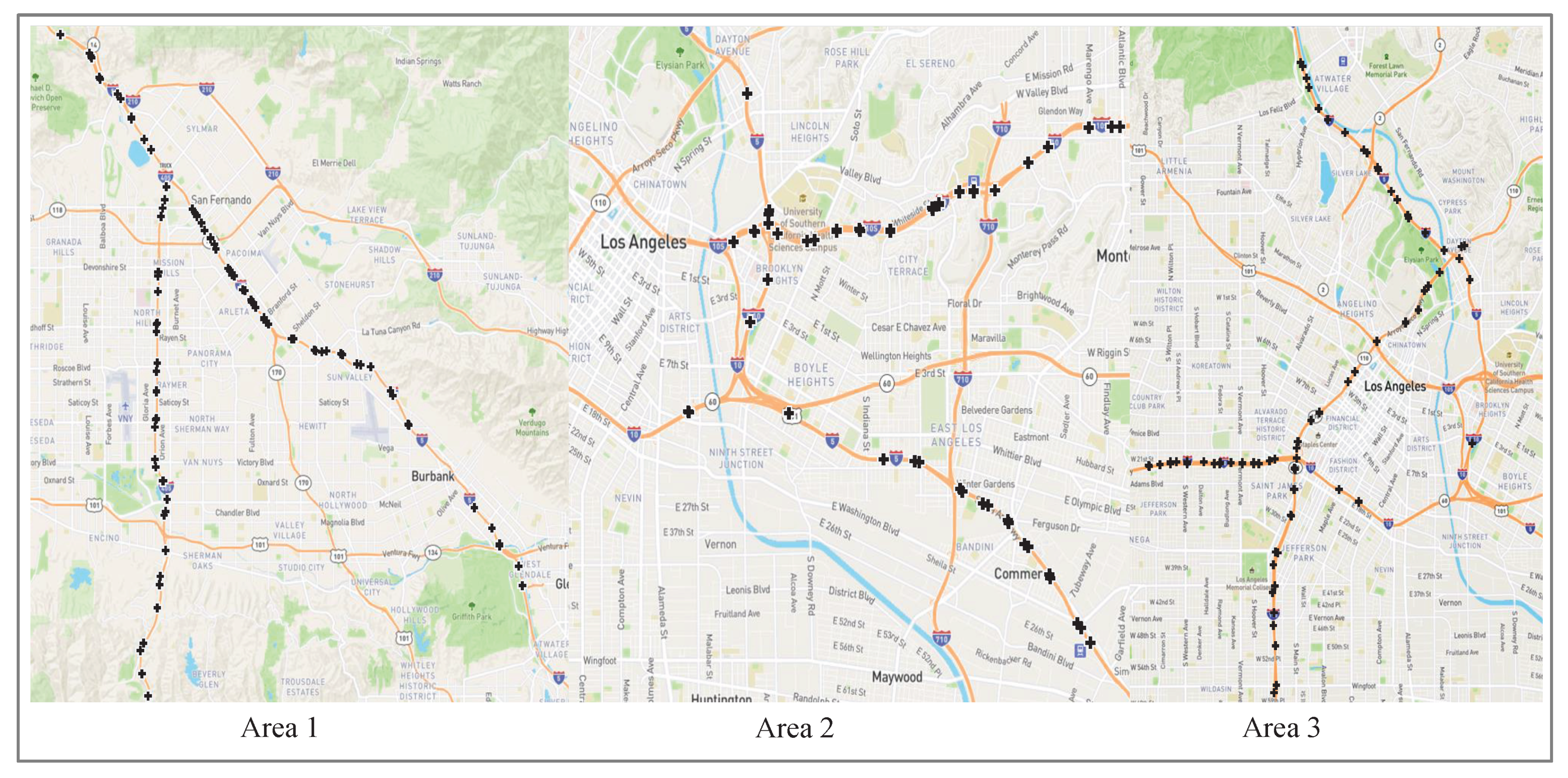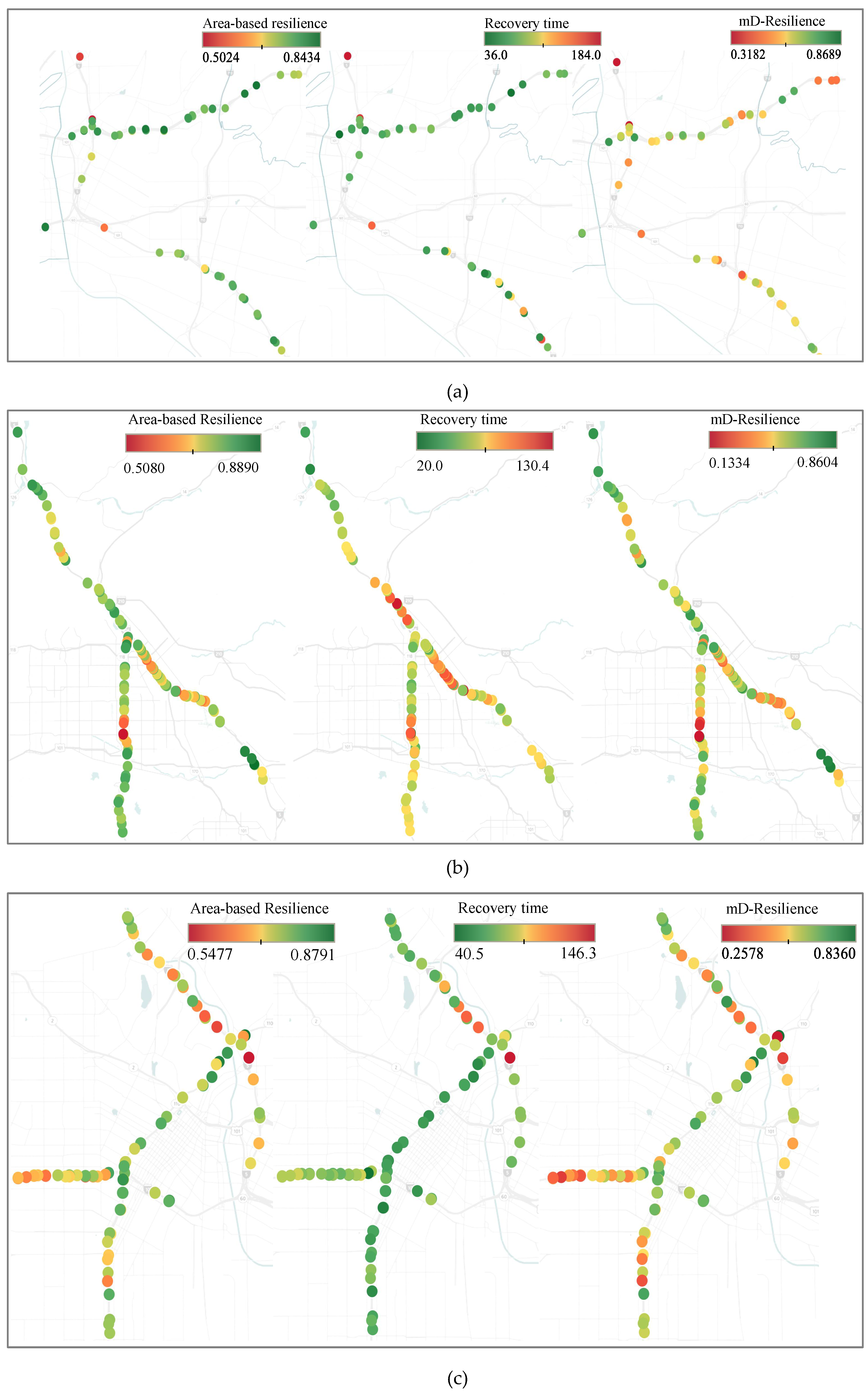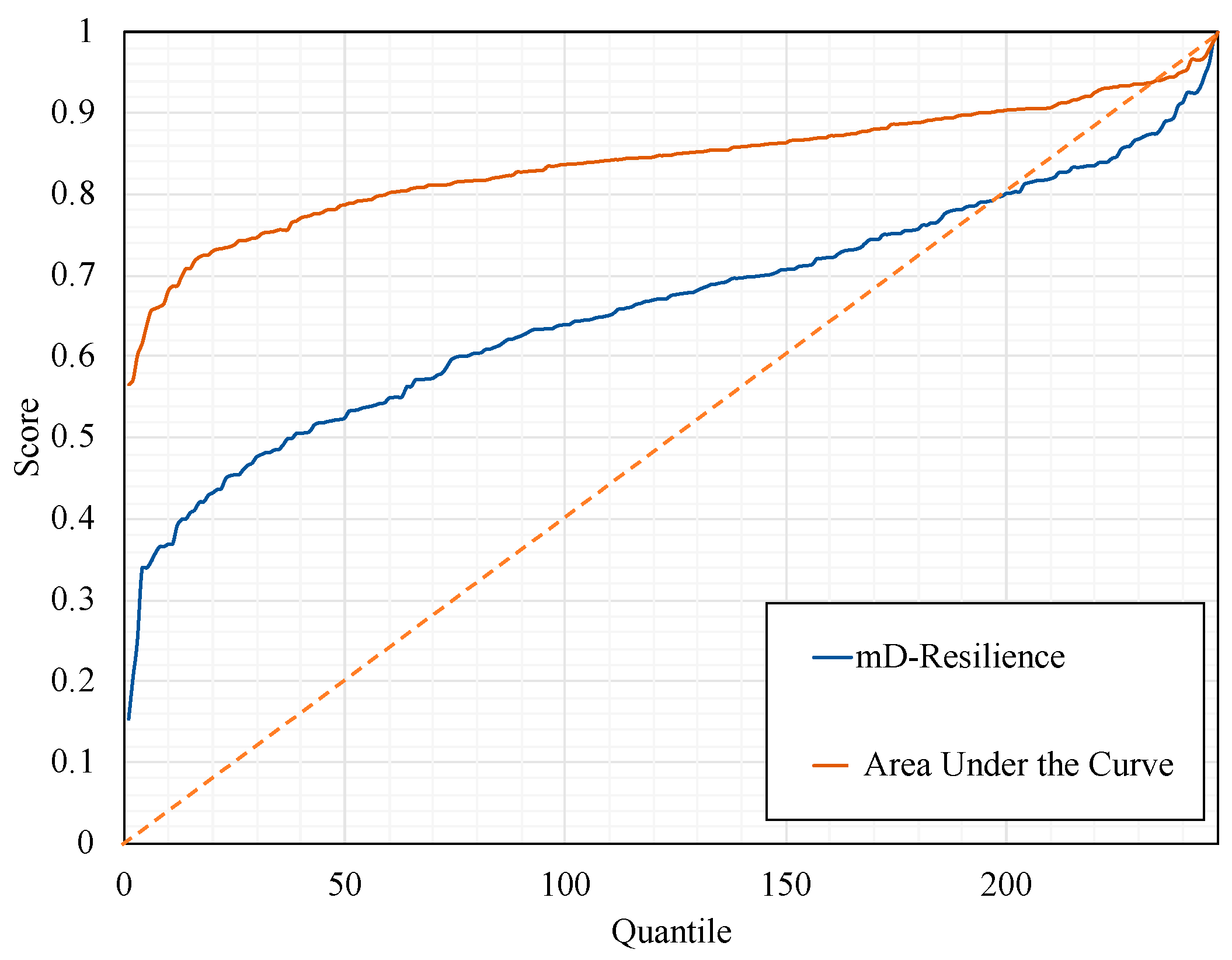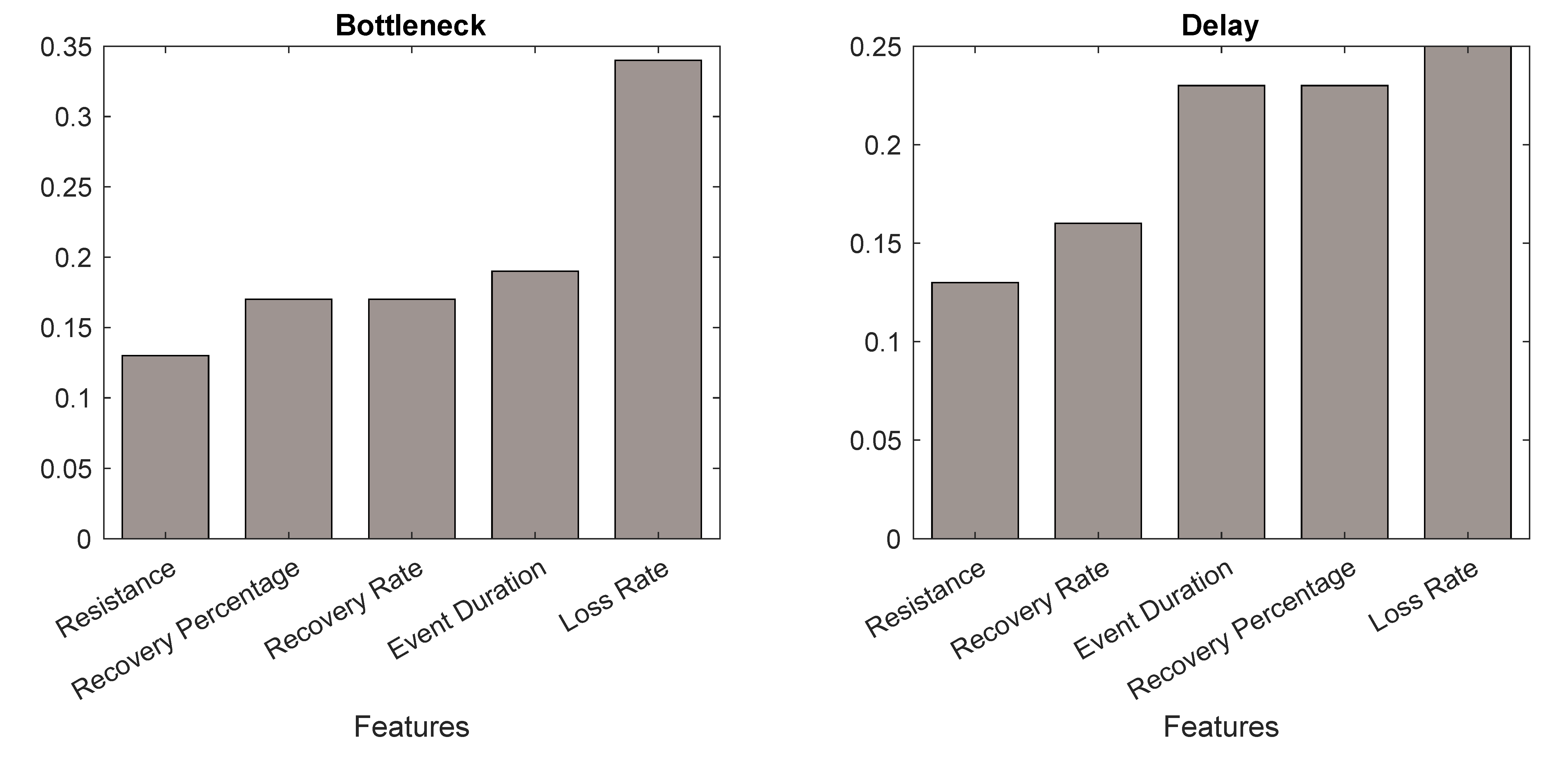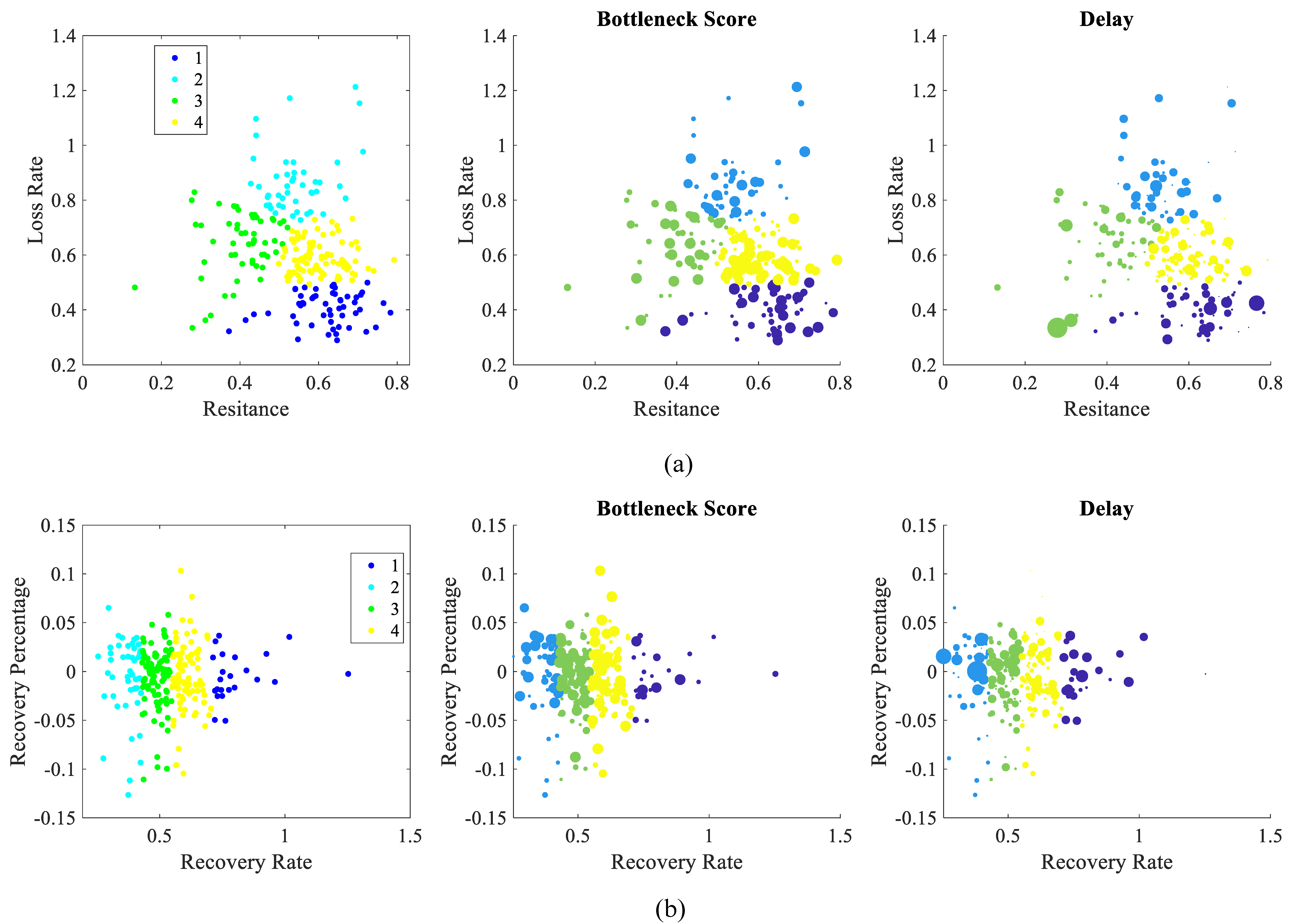1. Introduction
Resilience concept has been traditionally used in the context of extreme events to evaluate the operation of transportation systems. It is clear that extreme disastrous events can dramatically impact the mobility and the performance of transportation systems; however, high-probability low-impact (HPLI) disturbances can also play an important role in reducing the efficiency of such systems, mainly in the form of congestions, which in turn have a significant impact on sustainable mobility. HPLI disturbances not only cause delays and inconvenience, but also result in negative consequences such as air and noise pollution, high energy consumption, lower safety levels, and significant economic loss. These disturbances can happen due to numerous reasons such as bad weather [
1], poor condition of local infrastructure [
2], different speed regimes, the high volume of traffic [
3], or infrastructure design and operational configurations. Conventional methods of performance assessment in transportation systems account for mobility and reliability by leveraging quantification methods that center around travel time as an important factor for travel efficiency. Mobility-based indices quantify how mobility is affected compared to normal operational conditions, and reliability measures help plan according to affected travels. Several indices are used for the purpose of quantification including Travel Time Index (TTI), Travel Delay, Level of Service (LOS), and Buffer Index, among others. These metrics provide information on the severity of potential problems at different spatiotemporal scales. However, from an operational standpoint, it is important to understand how roadways withstand disturbances followed by congestions, and how they recover from such disturbances to the normal performance level. This could be viewed from the lens of resilience.
In the transportation domain, the resilience of a system reflects on attributes such as redundancy (multiple components with similar functionality), diversity (components with diverse functionalities), robustness, rapidity, or safety [
4,
5,
6]. The existing resilience studies in the transportation domain are primarily focused on supply-chain management and logistical operations aspects [
7] for major disturbances. On the other hand, recurrent HPLI disrupting events, such as traffic jams, have been less explored from the resilience perspective despite their considerable cumulative impact. Evaluating transportation system performance based on their resilience provides information on the behavior of roadways in coping with the imbalance considering the above attributes. This fact highlights the importance of studying the resilience of roadways to HPLI events in addition to using conventional metrics for performance assessments. In other words, the resilience concept could be utilized to provide supplementary information on how a system degrades and recovers, and potentially uncover the causes of system performance variations during congestions.
A common approach to characterize and quantify the resilience of a system is based on the resilience curve [
8], which is typically presented as a system performance indication curve plotted against time. Research studies mainly use the area under the resilience curve (from the time the disturbance occurs until the system is recovered) as an indicator of resilience; the area above the curve is called performance or resilience loss. However, this approach only considers the total loss of the system performance—also referred to as the “impact of disruption”—while resilience has multiple dimensions that could show the behavior of a system from different perspectives. Accordingly, we hypothesized that a multi-dimensional approach for quantifying complex resilience behavior of roadways across multiple stages of a resilience curve (i.e., degradation, absorption, and recovery) could result in higher information gain in performance assessment compared to solely relying on measuring the impact of disruption. Therefore, we proposed a process of multi-dimensional resilience (mD-Resilience) assessment for quantification of relative resilience across different roadway sections to assess their vulnerability to disturbances. This approach accounts for several attributes from the performance curve, as well as their aggregation (through Data Envelopment Analysis) as a scalar performance index. In this way, individual features and the aggregate score could be leveraged in assessing the performance.
Through a case study on three regions in major freeways of the Los Angeles metropolitan area and by leveraging the data from Performance Measurement System (PeMS), we have investigated how accounting for a multi-dimensional resilience-based scoring approach (mD-Resilience) could add value to the process of performance assessment for roadways and the associated decision-making. Through this case study, we have shown how the proposed resilience quantification technique could be also used to characterize the severity of conventional performance assessment techniques, such as delays and bottlenecks while providing a supplementary metric for assessment. In doing so, the remainder of this study is organized as follows.
Section 2 reviews the background pertinent to this research. We present the details of the proposed methodology in
Section 3. To illustrate the application of the proposed approach and answer the research questions, the case study on the Los Angeles area freeways is presented in
Section 4. Finally, the discussion of results and the conclusion are presented in
Section 5 and
Section 6, respectively.
2. Research Background
In the transportation domain, several performance metrics are used to measure the likelihood, the time, and the severity of roadways’ congestions. In general, measures aimed at investigating and reducing congestion should account for statistical techniques, replicability of the results, and the ability to describe the existing traffic [
9,
10]. Conventional methods of congestion assessment could be divided into two categories of mobility-based and reliability-based. The former refers to the metrics that are used to quantify and characterize the severity of reduction in mobility, and the latter focuses on probabilistic planning to mitigate the impact of congestion. In both cases, quantification metrics center around measuring the impact on travel time. Speed-based metrics (besides average travel speed) have been widely suggested in the literature. For instance, speed reduction index as the ratio of the decline in the speed from the free flow condition [
11] and Corridor Mobility Index (CMI) [
12] as the product of travel speed and peak-hour person volume per lane have been suggested as measures of congestion. Travel Time Index (TTI), as the most applied time-based congestion measure, compares peak period travel and free flow travel [
13] and provides guidance on identifying major issues. Travel Rate Index (TRI) computes the ratio of additional time needed for a trip due to congestion [
14]. There is also another set of measures based on the demand and capacity relation, such as Level of Service (LOS), which are more interpretable by the public audience. The LOS metric represents location-specific congestion, not the overall or regional congestion condition.
In addition to evaluating the performance, these metrics have been leveraged for investigating the mitigation strategies. For example, Gong and Fan [
15] proposed an approach for identification and ranking of recurrent bottlenecks in freeways using the reliability of travel time. Roshan and Mitra [
16] leveraged the commercial GPS fleet management devices in trucks to identify and classify bottleneck locations at highways based on the variation of speed. Moreover, Mishra et al. [
17] used empirical travel time data from INRIX [
18] to estimate travel time reliability. As these studies demonstrate, the conventional and long-established descriptors provide valuable information for characterizing the severity of congestion problems in roadways. However, they do not provide sufficient information on how the performance degrades (characterizing resistance to loss) and recovers (characterizing the ability to return to normal operations). These characteristics could be represented in the context of resilience.
As noted, in the transportation domain, resilience has been studied for the transport-related areas of logistics and supply chain management [
19], as well as organizational and economic perspectives [
20], and socioeconomic impacts [
21], specifically in case of extreme events and disasters [
22,
23]. While resilience analysis concerning roadways and networks has been the subject of several studies (e.g., [
24,
25,
26,
27]), the study of traffic flow and recurrent congestions have been briefly addressed in the literature [
7]. The existing research almost exclusively focused on the resilience of networks in the case of disasters [
28,
29,
30,
31]. Nevertheless, some authors have recognized the importance and leveraged the concept of resilience to characterize the performance of roadways for HPLI events. Tang et al. [
25] constructed a congestion metric based on the resilience engineering concept and transport science to quantify recurrent congestions’ severity based on spatiotemporal traffic patterns. They demonstrated that their proposed metric is comparable to conventional congestion quantification metrics, such as Level of Service and Relative Congestion Index, while providing some additional information. In another study, Calvert and Snelder [
7] presented the Link Performance Index for Resilience (LPIR), as an analytically developed scalar performance index, to evaluate the resilience level of individual road sections relative to a road network by accounting for resistance and recovery characteristics for minor disturbances like daily-based congestions. They visually compared the LPIR values with recovery time and the total delay of the roadways and specified that this metric provides additional information compared to the delay. Compared to the existing literature, our proposed contribution is a data-driven method that accounts for various features from the performance curve to characterize different stages of resilience. This method provides supplementary information in comparison to the conventional metrics of performance measurement, while it could be used to infer the severity of delay and bottlenecks.
Multi-dimensionality of resilience in the transportation domain has been emphasized and discussed from different perspectives. Murray-Tuite [
4] identified ten dimensions to characterize resilience including redundancy, diversity, efficiency, autonomous components, strength, collaboration, adaptability, mobility, safety, and ability to recover quickly. The study highlights the importance of resilience for daily events, as well as extreme events, and defines a resilient transportation system as the one with the ten mentioned characteristics. Nevertheless, general approaches to study the resilience of transportation systems and roadways evaluate resilience based on one or both of the following perspectives [
32]: (1) Resistance and ability to maintain functionality, and (2) rapidity and how fast the system recovers. Drawing on these perspectives, various metrics represented by recovery characteristics [
7,
24], the maximum deviation from the normal state [
33,
34], or network efficiency [
35] have been suggested for resilience quantification. For instance, Twumasi-Boakye and Sobanjo [
36] stated that resilience is measured by the entire performance loss from the occurrence of disaster to the full recovery of performance in a system. Liao et al. [
37] proposed a time-dependent resilience metric, defined as the ratio of recovery at a given time to the function loss at a previous point in time. While such single dimensions simplify the analysis, they may not capture different aspects of a system’s response, as they often focus on one stage of disturbance (loss in performance or recovery) [
38]. Hence, it is important to consider multiple dimensions simultaneously to better quantify a system’s overall ability to resist and recover from a disturbance [
39].
Although not explicitly addressed in the transportation domain, the multi-dimensional resilience quantification has been previously addressed to a limited extent in urban area resilience to disasters by Zobel and Baghersad [
38]. The authors characterized multiple dimensions of urban disaster resilience by leveraging the number of service calls. Their results showed the importance of considering multiple aspects of resilience (i.e., robustness and recovery time) in understanding the communities’ response to disasters. Nonetheless, other engineering and science disciplines have highlighted the importance of multi-dimensional resilience quantification. Therefore, we have proposed mD-Resilience to quantify the contribution of different resilience features, both individually and collectively, in evaluating the overall system resilience. The use of multiple aspects of performance when a disruption occurs will help gain a broader view of resilient behavior and provide a comprehensive method for added value in performance assessment and causation analysis as a supplementary source of information. To demonstrate these added values, we have utilized statistical measures of information gain and feature importance.
3. Materials and Methods
To address the research objectives, in developing the methodology, we have discussed the characteristics of the conventional resilience quantification methods to accentuate the need and importance of a multi-dimensional perspective in characterizing resilience. By leveraging the characteristics of a schematic performance curve of a system, we then proposed an approach for quantifying the resilience of roadway traffic from a multi-dimensional perspective. In doing so, and given the specific conditions of traffic flows on the roadways, we have accounted for two scenarios of (1) resilience to a single disturbance, and (2) resilience to a series of consecutive disturbances with temporal overlap.
3.1. Resilience Quantification
Like most engineered and infrastructure systems, roadways are exposed to minor and major disturbances and shocks. The disturbances result in the alteration of the system performance level over time. Facing a disturbance, the performance of the system first decreases (in a smooth or sudden path) and if resilient enough, it can recover from its disruptive state back to its operating state. There are four general stages that the resilience of a system is characterized with. The first stage is the normal state of operation with a performance of before a disturbance. The second stage, the degradation, is when the system performance degrades and starts to deteriorate down to the minimum level of following a disturbance at the time (). Next, if not collapsed, the system starts to improve its performance in the recovery state, and the performance will get to the normal state (full recovery) or close to the normal state (partial recovery). Finally, the system performance reaches the newly recovered state and becomes stable. The characteristics of these four stages are what we have leveraged to propose the mD-Resilience metric.
Multi-dimensional resilience quantification: Resilience has often been characterized using the area under the response curve (i.e., resilience triangle) [
8]; a smaller area corresponds to a less resilient system. The area-based approach for quantification of performance loss provides insight into the general performance of the system. However, it could not provide enough information on characterizing the differences between two events—i.e., whether the loss is due to a long recovery (gain) time or it is due to an intense loss in performance. For example, the area of the resilience triangles is almost equal in
Figure 1 (
). However, the rate of loss in performance and gain in performance (rate of recovery) are different, a reflection of different behavior of the system performance. In other words, there may be many different combinations of performance curve that results in the same total area under performance curves (quantified resilience). This is the foundation for our proposed investigation into the added value of the multi-dimensional resilience characterization approach. That is, the rate and intensity of the variations along the performance curve could be used to characterize the difference in resilience as a performance indicator. In addition to the area of the resilience triangle, other characteristics of the triangle (associated with different stages of loss and recovery) have been individually studied in different engineering disciplines [
40,
41]. However, in most complex systems, such as transportation systems, a single dimension might not be effective in characterizing the resilience and differentiating the relative performance of different components in a system.
Multi-event resilience quantification: Another important phenomenon of significant practical value in the context of this study is resilience characterization for consecutive events. Infrastructure systems, including transportation systems, may be prone to a sudden onset of a disturbance, followed by multiple sub-disturbances. Accordingly, a resilience quantification approach should also account for consecutive events and how they contribute to the overall resilience as individual single events.
3.2. Multi-Dimensional Resilience Indexing
Considering the above-mentioned factors, we have identified and defined a set of attributes that could better represent the functionality of a system when it comes to relative comparison of performance—specifically different sections in a roadway network in this study. These attributes include the attributes from existing literature across different engineering disciplines, as well as our defined attributes, including a modified characterization of resilience for multi-event circumstances. In what follows, we have presented the definitions, attributes, and the approach for combining these attributes as a single resilience score.
Figure 2 illustrates a schematic performance curve and its evolution during a disruption event to show the variables used in the following definitions.
Definition 1—Robustness Range: System performance normally varies over time within a tolerable range, which is referred to as Robustness Range (
) [
42]. In other words, robustness refers to the stability of a system state within a range of performance. This range could be used in characterizing the range in which a decrement in performance is an actual congestion event rather than a random fluctuation of the traffic. In this study, we have adopted the definition of a congestion event from Tang et al. [
25], which defined an event when the performance deteriorated out of the Robustness Range (
). Likewise, a system is recovered when the performance returns to the robustness range. The RR is quantified as a percentage of performance at the normal stage (
).
Definition 2—Event: An event is characterized based on the temporal performance curve of a system (i.e., roadways in our study). Having
as the start time of an event,
is the time the performance is recovered to a new state of equilibrium, and
(a time between
and
) when the system starts to recover for which:
then an event is characterized as [
39]:
where
is the performance of the system as a function of time.
3.2.1. Single Event Resilience Attributes
As noted, we have adopted and defined a number of attributes that could collectively characterize the effect of a disturbance and the response from a given system. These attributes are as follows:
Resistance (Re) indicates the impact of disturbance on the level of performance after degradation. Resistance gives a general insight into the non-operability of a system under disruptions. However, it does not convey information about how the system degrades following a disruptive event or how the recovery happens:
Loss rate (LR) is defined as the rate of drop in the performance during the degradation stage. L
R could provide information on the ability of a system to maintain its intended function. A smaller value of L
R means that the system shows more resistance to serviceability reduction, which is a desirable attribute:
Recovery rate (RR) is defined as the rate of gaining back the performance after reaching the minimum performance. The recovery rate can be derived from the performance curve from the time minimum performance happens until the time the system performance reaches its predefined normal level. Opposite to L
R, R
R could provide information on the ability of a system to get back to its intended function. The faster the system gets back to the intended operation level, the higher the R
R is:
Event Duration (D) defines the time that takes for a draw-down and draw-up cycle to take place. It mainly indicates the time the system performance is not at the level it was intended and designed for:
Recovery Percentage (R%) is an attribute that is used as a recovery path indicator. The recovery of a system after a disturbance could take different patterns and paths, leading to different recovery profiles. These differences in recovery are mostly due to the characteristics of a system (i.e., roadways in the context of this study). This concept has been depicted in
Figure 2. Moving toward recovery to a stable state, three main scenarios could happen: Improved recovery, stable recovery, or deteriorated recovery. These potential recovery scenarios are quantified by Recovery Percentage, which is defined as the percentage of improvement in performance after the recovery, compared to the initial normal stage. Recovery percentage could provide information on the overall impact of the event on the system performance. Moreover, the recovery percentage indicates the recovery mode—i.e., full-recovery, partial recovery, or performance improvement:
3.2.2. Multi-Event Resilience Attributes
A multi-event disturbance refers to a condition in which a disturbance or shock to a system is followed by multiple related sub-disturbances. Such circumstances are complex, and they typically involve partial recoveries, and they need to balance multiple criteria for effective actions [
43].
Figure 3 shows the schematic illustration of a multi-event disturbance.
Given a compound multi-event disturbance with n overlapping sub-disturbances, is the level of performance of the system after disturbance i occurs. Furthermore, is the performance level of the system before disturbance occurs, and is the duration from the state represented by to (i.e., duration for each partial recovery). Expanding on the single-event resilience attributes, in the generalized form, the multi-dimensional resilience attributes could be represented as follows:
Recovery Percentage (R
P):
3.2.3. Aggregated Resilience Index
The combination of the resilience-oriented attributes for a spatial system component represents its resilience. To consider the collective impact of these five attributes and determine the resilience, a method of aggregation is required. Most capacity-oriented methods use the weighted average as the aggregation method [
44]. Hence, the resilience score can be calculated in a general form by:
in which
represents the resilience attribute
, and
is the weight. In practice, the relative importance of attributes and thus the weights may depend on the context and decision-makers’ priorities. To avoid subjective weights, we used the Data-Envelopment Analysis (DEA) model, a non-parametric method of evaluating the performance and benchmarking the best practice among decision-making units (DMUs) [
45]. As an optimization problem, DEA identifies a production frontier including the best options among the decision-making units by considering multiple inputs and outputs. The non-parametric nature of the DEA model will enable aggregation without any assumption on different variables.
Suppose the goal is to analyze the efficiency of a set of
DMUs denoted by
for a set of inputs and outputs. Specifically,
uses
of input
and results in
of output
. An efficient DMU operates with minimal input and maximum output. In the DEA optimization, the input vectors of
and output vectors of
are given, and the input and output weights are varied to maximize the efficiency of DMUs. In this study, we use the BCC model, the most basic DEA model introduced by Banker, Charnes, and Cooper in 1984 [
46], where the events are the DMUs and resilience attributes are the set of input and output. A resilient response to an event is generated by lower values of loss rate and event duration (i.e., the input set) and higher values of resistance, recovery rate, and recovery percentage (i.e., the output set). DEA analysis returns a set of efficiency scores for each DMU, optimal weights of input and outputs, and slacks that show the waste in inputs and the surplus in outputs. We chose the output-oriented DEA model to maximize the efficiency (i.e., resilience) of events. Once the efficiency of events is derived, the scores will be aggregated over each road section (a system component in resilience quantification) with a harmonic average to describe the overall resilience of road sections. Linear programming formulation of the BCC model is represented by Equation (14):
where
is efficiency (i.e., resilience) of the
kth DMU,
are the set of inputs and
are the set of output, and
are non-negative scalars. The input and output variables are as presented in
Table 1.
3.2.4. mD-Resilience Quantification Process
The process of quantifying individual resilience dimensions (i.e., attributes) and mD-resilience aggregation is illustrated in
Figure 4. Different steps of this process were described as follows.
Step 1. Understanding and processing the data: The first step in the quantification of resilience is to select a key performance indicator (KPI). This is a source of data that shows how a system or a specific component in the system performs over time. As an example, in the case of recurrent congestions, speed could represent the performance of a roadway section.
Step 2. Event profiles characterization: Detection of events by using Equation (2) on KPI profiles results in a performance curve for resilience assessment.
Step 3. Quantifying individual resilience dimensions: Using the temporal profile of each event, five individual resilience dimensions are calculated.
Step 4. mD-Resilience aggregation: With five resilience dimensions calculated for each spatial unit of evaluation, the metrics will be aggregated by using BCC DEA model to represent the resilience score. In doing so, the data from multiple events are used to quantify an aggregate resilience score.
5. Discussion
Given the multi-dimensional nature of the resilience concept for characterizing the performance of roadways and transportation systems, our proposed approach supports combining multiple attributes of resilience into one dimensionless measure, while still providing information on individual stages of resilience. This approach also accounts for novel attributes of “recovery percentage” and “multi-event resilience” to take the recovery paths and partial recovery into consideration. The resilience score is calculated as a relative measure to rank the roadway sections according to their performance as a supplementary metric compared to conventional performance assessment metrics. The research efforts that have used resilience for performance assessment of congestion events have also argued that the use of resilience concept in the quantification of performance has resulted in added information to conventional metrics, such as the delay in travel time [
7] and relative congestion index (RCI) [
25], which measures the ratio of travel time in congestion to free flow. The increase in the information gain enables a better distinction between different decision-making units (i.e., road sections) for planning purposes. One of the primary advantages of the mD score is that it allows the decision-makers to better understand the relative importance of each attribute for sections with similar resilience scores. Such information may also be used by local authorities for planning resource allocation either for mitigation of loss in performance or for the acceleration of the recovery process.
It should be also noted that the proposed mD-Resilience quantification framework could be applied for performance assessment of systems with different scales, as it uses features from resilience/performance curves of a decision-making unit. For any disruptive event, if a representative key performance indicator (KPI) could be used to form the performance curve and represent system degradation and recovery with sufficient resolution, the mD-Resilience framework and scoring could be applied assuming satisfactory conditions for DEA utilization. However, in this study, we have only presented the performance assessment of roadway sections (as the spatial units) and for the HPLI events considering our motivation and case study. In doing so, we looked at the relatively high-resolution traffic speed data as the KPI and calculated the resilience metrics and their collective impact to quantify the resilience scores. Therefore, the applicability assessment of the framework for other problem domains has remained for future studies. Factors that could influence the outcome of the analysis include data availability and resolution, and the scale of the data analysis (both spatial and temporal). The temporal resolution of the data could change the detected events, the finish time of the event, and as a result, change the values of recovery-related metrics. We have used the average speed of the vehicles (at 5-minute intervals) collected from the stations installed on the freeways. However, the results may differ depending on data availability and type. For example, low-resolution GPS data or other types of onboard mobile sensors could change the representation of the performance curves. In future directions of this research, case studies with various levels of temporal and spatial scales should be taken into account to investigate how these factors change the formation of performance curves and the extraction of resilience attributes. Such investigations will shed light on the data requirements for using the mD-Resilience framework.
The proposed approach reveals the resilience of different sections as symptoms of problems and does not necessarily provide information on potential spatial dependencies in a network. Although this metric provides information on the resistance and recovery stages in coping with a disturbance, causality inference calls for an understanding of the spatial dependencies. Physical and operational characteristics of roadway networks and their impact on upstream and downstream flow in roadways are important in understanding these casualties. However, unlike conventional performance metrics that only identify the severity of the problem, by using the proposed mD-Resilience scoring framework, further information on the coping mechanisms could be identified. Identifying the spatial autocorrelation and propagation of the disturbance waves due to bottlenecks by using data-driven analysis, mathematical modeling, or simulations of road networks are required to infer the causality of observed resilience on the roadway sections.
In this study, we used BCC DEA method, and therefore the evaluations across different DMUs (i.e., road sections) are relative. Other alterations of DEA, such as pairwise comparison, could be further added to enhance the analysis and rank the DMUs with an absolute scale when there is a similar DEA score for multiple DMUs. Furthermore, in real-world situations, different road sections operate in different environments. While we sought to address this by taking the land use classification into account, contextual variables such as road layouts (i.e., the number of lanes, width of roadways, existence of on-ramp and off-ramp, and High Occupancy Vehicle (HOV) lanes) could contribute to the operational conditions and resilience of roadways. This type of information could be added to DEA as the environmental variables, which are often the variables over which the decision-makers have little or no control and are regressed on efficiency scores.
6. Conclusions and Future Work
In this study, a multi-dimensional resilience quantification framework (mD-Resilience) was proposed and evaluated for assessment of the road sections resilience to recurrent (daily based) congestions as a case study. The methodology considers resilience as a complex concept that cannot be fully described by a single feature. Instead, it simulates resilience as the efficiency of a decision-making unit (DMU) (i.e., road sections in our case study) with multiple inputs (representing degradation in performance) and output (representing recovery in performance) sets. Data envelopment analysis (DEA) was adopted for aggregating different features that characterize resilience through maximizing the efficiency of DMUs by using loss rate and event duration as input parameters and resistance, recovery rate, and recovery percentage as output parameters. The non-parametric nature of DEA eliminates the use of assumptions for any relationship between the input and the outputs.
The assessment of the mD-Resilience quantification approach was conducted in a case study for 248 freeway sections in Los Angeles, California on the data from the Caltrans Performance Measurement System (PeMS). Through statistical assessments, it was demonstrated that the mD-Resilience quantification approach could provide supplementary information (compared to conventional metrics such as delay) for performance assessment. Furthermore, it was shown that compared to resilience quantification according to the area under the curve, the mD-Resilience approach results in increased information gain in the assessment of the relative performance reflected in increased entropy for scores across a region. Through decision tree classification analysis, it was further shown that the resilience features introduced in this study could be used to characterize the severity of delays and bottlenecks at three levels of low, medium, and high. Furthermore, feature importance assessments showed that all the individual features are important in characterizing the response of roadway sections; therefore, drawing conclusions on the performance of different sections based on the loss stage or recovery stage alone is not feasible. The future directions of this research include understanding the impact of spatiotemporal data resolution, understanding the implications of mD-Resilience on macroscale transport and mobility problems, and investigating the causality analysis and recommender system though spatial autocorrelation analysis and congestion propagation modeling.
